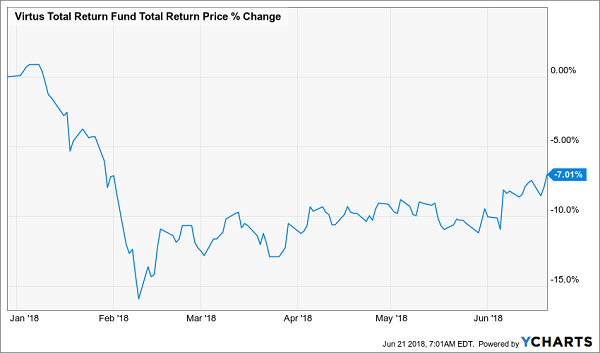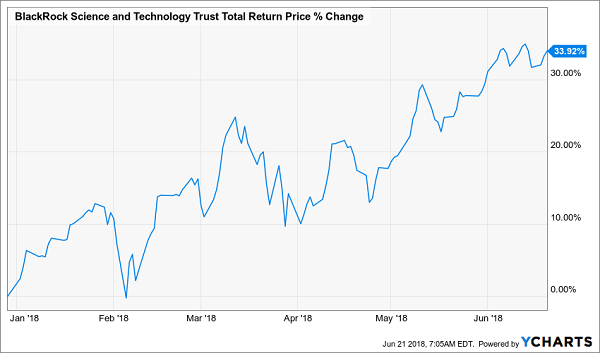With over 500 closed-end funds (CEFs) on the market, how do you choose the best one?
It’s not an easy question to answer, because there are literally dozens of metrics any CEF investor should look at before buying.
But you don’t have to worry, because in a moment, you’re going to get the “guts” of the 5-point system I’ve carefully designed to pick winning CEFs for our CEF Insider service.
So why is it important to have a good system?
Because if you don’t, you could find yourself holding an empty bag—like investors who bought the Virtus Total Return Fund (ZF) at the start of the year because they were seduced by its 15.3% dividend yield.
Sadly, that move resulted in a massive loss in no time flat, even with dividend payouts:
The Perils of a High Yield

What’s even sadder is that there are plenty of funds that invest in the same assets as ZF that have done far better over the long term. Take the Liberty All-Star Growth Fund (ASG), which also focuses on high-growth stocks and is up a nice 22.8% since the start of 2018.
A Better Long-Term Pick

This is one of many instances where blindly buying a CEF would have cost real money. So how do you avoid the trap?
My 5-Point System
When choosing CEFs, I look at 5 crucial points that drive each buy call I make. And they can help guide you, too. They are:
- Management: How good is the team at the top, and has the fund changed horses lately (frequent management changes are an obvious red flag)?
- Discount: What’s the fund’s discount to its net asset value (NAV, or the value of its underlying assets), and what has that markdown been historically? We want a current discount well below the long-term average to drive our upside.
- Portfolio: What does the fund hold now, are there any big changes to the portfolio, what’s the rationale behind those changes, and how are those assets going to perform in the future?
- Dividend: How sustainable is the payout, what are the chances of a dividend cut, and how low can the payouts go? (Key here is to look at yield on price, yield on NAV, changes in NAV and total net investment income, or NII)
- Current Climate: How does the fund’s investment strategy fit within your broader portfolio and view of changes in the broader economy?
In other words, the system combines a variety of bottom-up questions about the fund’s portfolio, strategy and management with top-down questions about the asset class and economy as a whole.
The System in Action
To show how this works, let’s look at a recent example: the BlackRock Science and Technology Trust (BST). Although this fund had soared a massive 58.6% in 2017, my system still urged readers to jump head-first into this high-quality fund just as 2018 arrived, because it ticked all the right boxes. You can read my original recommendation here.
Judging by who was managing this fund, the market price and NAV performance, and the sustainability of its payouts, it was clear that this fund was not done rising. That turned out to be accurate: BST has given investors a 33.9% total return since my system flagged it less than six months ago:
A Quick Ride Up

What makes this performance all the more impressive is that it is more than double the fund’s index, the Nasdaq 100. If you tried to get into that index with the “dumb” passive index fund, the Invesco QQQ Trust (QQQ), you’d be missing out on $1,971 for every $10,000 invested.
In less than six months.
3 CEFs to Put on Your Watch List Now
Nowadays, there are a couple dozen CEFs that are getting to that perfect place where the fundamentals and the broader economic climate are combining to create a perfect storm for massive upside and sustainable high yields.
The first is the BlackRock Resources & Commodity Fund (BCX), a commodity specialist that has done well in a tough environment for commodities. It’s an example of a well-managed portfolio with a great management team—but while the bottom-up is good for BCX, we’re not quite there from a macro standpoint yet. But we’re getting closer.
In the utilities world, there’s the Gabelli Global Utility Fund (GLU), which is diversified and has the added bonus of going beyond the US to take advantage of currency fluctuations. I haven’t added it to the CEF Insider portfolio yet, for a couple of reasons. For one, its 3.9% dividend is too small, and its discount to NAV isn’t low enough, given how rising interest rates tend to lower demand for utilities stocks.
Instead, I’ve chosen a diversified equity fund with a bigger discount than GLU’s and a REIT fund that is less sensitive to higher interest rates.
And both of those picks are up nicely, up 13.6%, on average, since my recommendation, while GLU has gained just 9.1%. And instead of paying a 3.8% dividend, these two picks are paying 8.1% each. (Click here to get access to my complete CEF Insider portfolio, including these two fund picks.)
Finally, another interesting fund for your watch list is the BlackRock MuniHoldings Fund (MUH), a municipal-bond fund with a massive 5.8% dividend payout (which is tax-free for many Americans). MUH is also one of the best-performing muni-bond funds in the CEF universe (its 7.5% annualized return over the last decade is far above the 5.2% average across muni-bond CEFs).
Not only is BlackRock the biggest municipal-bond investor in the world, giving it a big edge in this complex market, but MUH’s 8.8% discount to NAV is far bigger than its average 3.4% discount over the last decade.
The only problem? Interest rates. The market still hasn’t priced in the Federal Reserve’s aggressive rate hikes for this year and the next, but when it does, this fund will be ideally positioned to buy and hold for years.
Please don't make this huge dividend mistake... If you are currently investing in dividend stocks – or even if you think you MIGHT invest in any dividend stocks over the next several months – then please take a few minutes to read this urgent new report. Not only could it prevent you from making a huge mistake related to income investing, it could also help you earn 12% a year from here on out! Click here to get the full story right away.